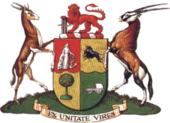Natives Land Act, 1913
| Natives Land Act, 1913 | |
|---|---|
 | |
| Parliament of South Africa | |
| |
| Citation | Act No. 27 of 1913 |
| Enacted by | Parliament of South Africa |
| Royal assent | 16 June 1913 |
| Commenced | 19 June 1913 |
| Repealed | 30 June 1991 |
| Administered by | Minister of Native Affairs |
| Repealed by | |
| Abolition of Racially Based Land Measures Act, 1991 | |
| Related legislation | |
| Native Trust and Land Act, 1936 | |
| Status: Repealed | |
The Natives Land Act, 1913 (subsequently renamed Bantu Land Act, 1913 and Black Land Act, 1913; Act No. 27 of 1913) was an Act of the Parliament of South Africa that was aimed at regulating the acquisition of land.
Overview
The Natives Land Act of 1913[1] was the first major piece of segregation legislation passed by the Union Parliament. It was replaced in 1991. The act decreed that natives were not allowed to buy land from whites and vice versa. Exceptions had to be approved by the Governor-General. The native areas left initially totaled less than 10% of the entire land mass of the Union, which was later expanded to 13%.[2]
The Act further prohibited the practice of serfdom or sharecropping. It also protected existing agreements or arrangement of land hired or leased by both parties.[1]
This land was in "native reserve" areas, which meant it was under "communal" tenure vested in African chiefs: it could not be bought, sold or used as surety. Outside such areas, perhaps of even greater significance for black farming was that the Act forbade black tenant farming on white-owned land. Since so many black farmers were sharecroppers or labor tenants that had a devastating effect, but its full implementation was not immediate. The Act strengthened the chiefs, who were part of the state administration, but it forced many blacks into the "white" areas into wage labor.[3]
Impact
The opposition was modest but vocal. John Dube used his newspaper to create an issue. As president of what would become the African National Congress, he supported whites like William Cullen Wilcox, who had created the Zululand Industrial Improvement Company. That had led to them supplying land to thousands of black people in Natal.[4] Dube was one of five people who were sent to Britain to try and overturn the law once it came into force in South Africa.[5]
Sol Plaatje traveled to Britain with the SANNC (later the African National Congress) to protest the Natives Land Act but to no avail. He collected transcripts of court deliberations on the Natives Land Act and testimonies from those directly subject to the act in the 1916 Book Native Life in South Africa.[6]
Political ironies
Much political irony surrounded the Act:
- The minister at the time of its introduction, J.W. Sauer, was a Cape Liberal who opposed disenfranchisement of blacks. He, however, advocated for "separate residential areas for Whites and Natives" in the Parliamentary debate on the bill.
- John Tengo Jabavu, a prominent "educated African" welcomed the Act,[7][8][9] but Merriman[citation needed] and Schreiner[citation needed] opposed the Act on principle.[10][11][2]
See also
References
- ^ "19 June 1913 Native Land Act Archived 14 October 2010 at the Wayback Machine", This day in history, publish date unknown (accessed 20 December 2007).
- ^ Collins, Robert O. and James M. Burns: A History of Sub-Saharan Africa, p. 346. Cambridge University Press, 2007
- ^ Talley, Clarence R.; Cotton, Bernard (20 May 2019), "Minority Concentration and Black-White Inequality in U.S. Labor Market Areas", Inequalities in Labor Market Areas, Routledge, pp. 237–255, doi:10.4324/9780429042416-13, ISBN 978-0-429-04241-6
- ^ "Zuma: Address by the President of South Africa, at the 100 year celebration conference of the women's organisation of the united congregational church of Southern African KZN region (31/03/2012)". polity.org.za. Retrieved 1 August 2013.
- ^ Natives Land Act, SAHistory.org.za, accessed 1 August 2013
- ^ Plaatje, Sol (1916). Native life in South Africa before and since the European War and the Boer rebellion. London: PS King. ISBN 0582785898.
- ^ Gershoni, Yekutiel (1997). "The South African Liberal Movement and the Model of the American South". In Gershoni, Yekutiel (ed.). Africans on African-Americans. Palgrave Macmillan UK. pp. 145–175. doi:10.1007/978-1-349-25339-5_7. ISBN 978-1-349-25339-5.
{{cite book}}:|work=ignored (help) - ^ Beinart, William; Delius, Peter (4 July 2014). "The Historical Context and Legacy of the Natives Land Act of 1913". Journal of Southern African Studies. 40 (4): 667–688. doi:10.1080/03057070.2014.930623. ISSN 0305-7070.
- ^ Walshe, A. P. (1969). "The Origins of African Political Consciousness in South Africa". The Journal of Modern African Studies. 7 (4): 583–610. doi:10.1017/S0022278X00018851. ISSN 0022-278X. JSTOR 159153.
- ^ Feinberg, Harvey M. (1993). "The 1913 Natives Land Act in South Africa: Politics, Race, and Segregation in the Early 20th Century". The International Journal of African Historical Studies. 26 (1): 65–109. doi:10.2307/219187. ISSN 0361-7882. JSTOR 219187.
- ^ see C.F.J Muller (ed), 500 Years, History of South Africa as well as references therein
Bibliography
L.M. Thompson, A History of South Africa!
